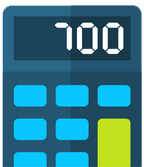Income Tax Calculator – How to Calculate Income Tax
Our income tax calculator can help you figure out your take home pay after tax has been deducted.
Take home pay, also called net pay, is the salary you have left after deductions like income tax and national insurance have been made by your employer or pension provider.
The income tax calculator will give you an estimation of the tax and national insurance you pay through your salary under PAYE as well as an estimate of your monthly take home pay.
Figuring out your take home pay is a useful exercise to help manage your own personal budgets and future financial plans.
How to calculate your net pay using the Income Tax Calculator:
- Select a tax year – you can only go back four tax years.
- Enter your total annual salary.
Please read on to find out more about how income tax affects your take home pay, the process of refunding income tax and what you can do to increase the amount of pay you take home each month.
How does the Income Tax Calculator work?
The main figures used to calculate the estimated tax, national insurance and monthly take home pay are:
- The tax free personal allowance for the tax year. This means you only pay tax on earnings over the tax free allowance.
- Any other income under PAYE for example from a pension.
- Depending on how much you earn you can pay tax at different rates. The rates are currently 20%, 40%, and 45%.
- Your tax code which can vary depending on different factors. If it’s wrong you can overpay or underpay tax. You can find out more about tax codes in our tax code guide.
How your income tax bill is calculated plays a major part in working out your overall take home pay but don’t forget about national insurance and other automatic deductions like student loans.
What factors affect my take home pay?
There are a number of factors that can affect how your take home pay is calculated.
Checking that your net pay is accurate can highlight areas that may need some attention.
Understanding what can impact your net pay let’s you predict and fix any issues as soon as possible which can help increase the amount of pay you are left with.
Factors that can impact your take home pay include:
- Tax codes: If your tax code is incorrect it’s easy to pay too much or too little income tax. You should check your tax code periodically and contact HMRC if you think it’s wrong.
- National minimum wage: If you qualify for the national minimum wage you should check on your payslip that you are being paid the correct hourly rate. If you are being paid below the national minimum wage you can ask your payroll department or HMRC for assistance.
- Student loans: If you are paying back a student loan this will be taken from your salary by your employer before you are paid.
- Pension contributions are typically deducted from your pay before tax is taken.
What is my pay after tax?
Checking how much your take home pay will be after tax and national insurance is a popular search query on Google.
We have picked out some of the most frequent searches based on some average UK salaries.
The figures provided are calculated using the income tax rates and the basic personal allowance from the 2024/25 tax year with no other deductions taken into account.
Common online search’s on Google for “after tax” figures include:
What is £30,000 after tax?
Take home pay after tax on a salary of £30,000:
- Annually £24,771
- Monthly £2,064.25
- Weekly £476.37
Income Tax
- Annually £3,486
- Monthly £290.50
- Weekly £67.04
National Insurance
- Annually £1,743
- Monthly £145.25
- Weekly £33.52
What is £35,000 after tax?
Take home pay after tax on a salary of £35,000:
- Annually £28,271
- Monthly £2,355.92
- Weekly £543.67
Income Tax
- Annually £4,486
- Monthly £373.83
- Weekly £86.27
National Insurance
- Annually £2,243
- Monthly £186.92
- Weekly £43.13
What is £40,000 after tax?
Take home pay after tax on a salary of £40,000:
- Annually £31,771
- Monthly £2,647.58
- Weekly £610.98
Income Tax
- Annually £5,486
- Monthly £457.17
- Weekly £105.50
National Insurance
- Annually £2,743
- Monthly £228.58
- Weekly £52.75
What is £45,000 after tax?
Take home pay after tax on a salary of £45,000:
- Annually £35,271
- Monthly £2,939.25
- Weekly £678.29
Income Tax
- Annually £6,486
- Monthly £540.50
- Weekly £124.73
National Insurance
- Annually £3,243
- Monthly £270.25
- Weekly £62.37
What is £50,000 after tax?
Take home pay after tax on a salary of £50,000:
- Annually £38,771
- Monthly £3,230.92
- Weekly £745.60
Income Tax
- Annually £7,486
- Monthly £623.83
- Weekly £143.96
National Insurance
- Annually £3,743
- Monthly £311.92
- Weekly £71.98
What is £60,000 after tax?
Take home pay after tax on a salary of £60,000:
- Annually £44,603.40
- Monthly £3,716.95
- Weekly £857.76
Income Tax
- Annually £11,432
- Monthly £952.67
- Weekly £219.85
National Insurance
- Annually £3,964.60
- Monthly £330.38
- Weekly £76.24
How can I increase my take home pay?
After you have figured out what your take home pay is it is worth exploring ways to keep more of the money you are earning.
Individuals who are employed have some options that can reduce their taxable income by using tax free allowances and tax reliefs.
Claiming back what you can from HMRC will decrease your tax bill which in turn boosts the amount of pay you keep.
- Expenses of employment: HMRC gives employees under PAYE tax relief on some expenses incurred because of their job.
If applicable the tax relief reduces your income tax bill and can mean you are owed a tax rebate from the past. We cover this subject a bit more below.
- Tax free savings ISA
Savings income is taxable after the personal allowance and savings allowance have been used.
Using an individual savings account also known as an ISA let’s you receive the interest from savings kept within the ISA free from tax.
- Tax free premium bonds
Using premium bonds is another way to receive income from savings free from tax.
Having premium bonds gives you the opportunity to win tax free prizes worth up to £1 million.
- Tax free self employed trading allowance
The self employed trading allowance can be used to reduce tax on income from self employment under the trading allowance threshold.
- Tax free property allowance
The property allowance can be used by individuals who have rental income from property.
Using the property allowance allows property income up to the threshold to be earned free from tax.
- Tax free dividend allowance
The dividend allowance is applicable to income from dividends up to the allowance threshold.
Using the dividend allowance can reduce the tax you pay on income from dividends in the tax year they are received.
- Tax free pension contributions
By contributing to your pension a portion of the money that would otherwise be paid as tax to the government is redirected into your pension fund.
If you currently contribute to a workplace pension via salary sacrifice your employer may permit you to make additional pension contributions up to the pension allowance limit.
This approach can help lower your tax liability while simultaneously boosting your income when you are retired.
Find out more about tax refunds
Finding out more about why you could be owed a tax refund can really pay off and increase your take home pay each month.
Because there are a number of different reasons that can result in a tax refund being due it’s always best to discover which could apply to you for as far back as the last four tax years.
You can then make an informed decision about what applies to you and avoid missing out on any entitlements you are eligible to.
If none of the options available apply to you currently they may in the future which means at least you know what can be done and when to make a claim.
Do I qualify for tax back?
To qualify for tax back you need to meet set criteria and then follow a particular process to claim any refund due.
Some of the most popular reasons to be eligible and for the costs you incur because of your job.
HMRC sets the rules and calls these costs employment expenses.
These employment expenses include:
- Claiming mileage for using your own car, van or motorcycle to temporary workplaces.
- Buying tools for work purposes.
- Paying into a union or professional body.
- Washing your own uniform or protective clothing.
- Leaving the UK within the last four tax years.
In most cases it’s down to you to claim back the income tax you are owed.
The tax man expects you to make a claim but put’s the responsibility on you as the taxpayer to start the process.
For deadline purposes always remember that the tax year doesn’t follow the normal calendar year and starts on the 6th April and ends on the 5th April the following year.
There is a time limit to claim a tax refund
There is a time limit of four tax years for you to claim your refund. This could be good news because if you have overpaid income tax in more than one tax year you could get a larger tax rebate than you expected.
It also means you should act as quickly as possible to ensure you don’t miss out with the deadlines being very strict.
How do I claim income tax back from HMRC?
The process of claiming your tax back from HMRC is specific to the type of refund you are reclaiming.
For example if you are reclaiming tax relief for employment expenses a form P87 should be completed either through the HMRC online portal or by post.
You can find out more about how to claim your tax refund in our how to claim an income tax refund guide.
You can contact HMRC online or by phone and you can find specific HMRC contact information here.
Our other tax refund calculators
Tax Rebate Services has produced multiple tax refund calculators to help support you on your tax rebate journey and they are all completely free to use.
The calculators cover many of the popular subjects surrounding refunds and taxpayers who overpay income tax.
Tax refund calculators by Tax Rebate Services:
- Uniform tax calculator for washing your own uniform and protective clothing.
- Mileage tax relief calculator for using your own vehicle to travel to temporary workplaces.
- UK tax back calculator if you leave the UK for the current and last four tax years.
- Tool tax refund calculator if you purchase your own tools to do your job.
- Car and vehicle mechanics tool tax rebate calculator if you buy your own tools for work purposes.
- MOD mileage tax rebate calculator if you work for the MOD and travel to temporary assignments.
- CIS tax rebate calculator if you are a self employed CIS subcontractor.
- Pension tax rebate calculator if you pay into your own private pension scheme and are a higher rate taxpayer.
After you have used our refund calculators you will be given more information on each subject to guide you through the HMRC claims process.







